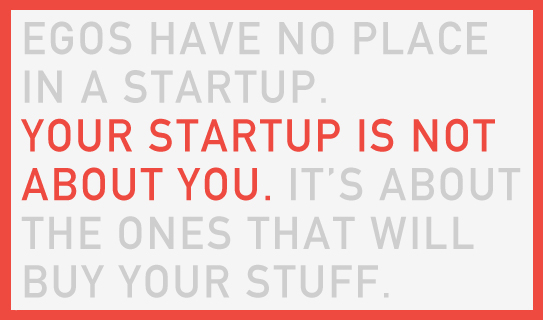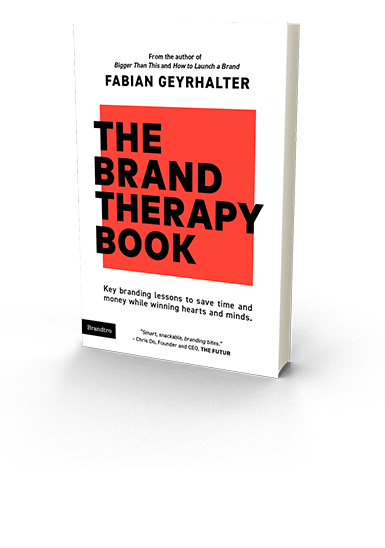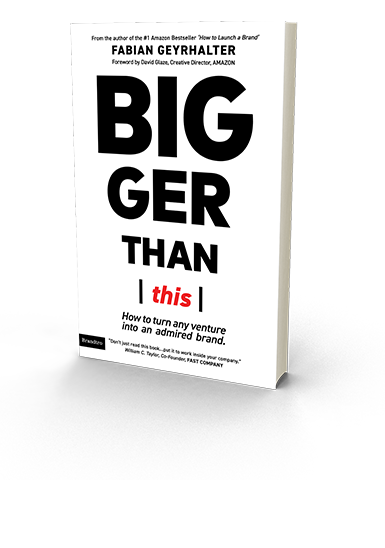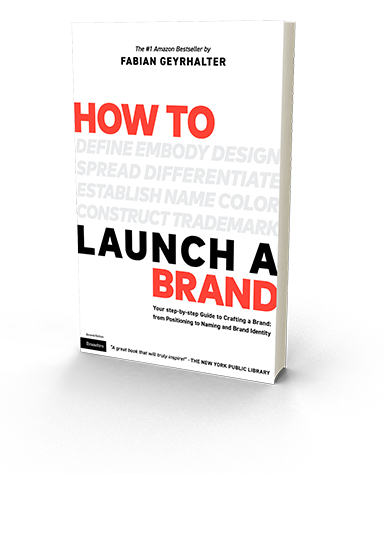Tag Archives: Toms
Turn Any Venture Into a Brand — by Caring Deeply About a Mutual Cause
Below article was first published on Sustainable Brands on 01/25/18.
This is an excerpt from Fabian Geyrhalter’s upcoming book, Bigger Than This: How to Turn Any Venture Into an Admired Brand. One of eight traits discussed in Bigger Than This is ‘cause,’ which we dive into here…

Aligning your commodity brand’s existence with a cause can give you strong brand positioning, if done truthfully. Will Young, founder and president of Sydney-based Campos Coffee, states his reason for a purpose- and cause-oriented brand in a company video: “If we are not in it for good, then there is no reason to wake up every morning and go to work.” His words would not be as powerful if Campos Coffee had not demonstrated its commitment to ethics and philanthropy in coffee by being a Fair Trade Certified organization that calls itself “Direct Trade” by improving education and living standards of the communities with which it works.
There is a powerful reason his approach works. Over the past five years, it has become somewhat of a staple for startups founded by millennials to identify a social cause that can be activated in an authentic way to manifest that the purpose of a product or service goes deeper than solely generating sales. “Purpose” is ingrained in their thinking. Millennials’ emphasis on purpose is probably why there is even a startup, Pledge 1%, to foster startups that seek to commit 1% of their equity, product, profit or time to charity. As Pledge 1% CEO Amy Lesnick told Fast Company: “In 15 years we might not even exist, as early-stage philanthropy will be as common as setting aside equity for future employees.”
The best way to tap into the cause-related marketing trend is to think unselfishly. If you are an entrepreneur considering selling any product, whether a commodity or not, ask yourself why it matters to bring it into this world at this very point in time (and for the long term), and why your audience will deeply care about an often otherwise labeled “so what?” product.
One brand that has answered this question in a unique way is the Package Free Shop. It started as a commodity store (wait, a store just by itself is seen as a commodity by many today!) that specializes in selling commodities such as toothbrushes, razors, soap, bags, laundry detergent, etc. The Package Free Shop is 100% cause-based, selling reusable alternatives to single-use, disposable commodities while teaching customers how to live a “zero-waste life.”
Also ask yourself what your brand will be giving back. Can you identify a social cause that can be activated in an authentic way to demonstrate that the purpose of your product/service goes deeper than solely generating sales? That is the easiest way.
Research shows how much consumers value brands that support charitable causes. A recent cause marketing survey conducted by research firm Toluna showed that 39% of consumers buy into integrated cause strategies such as the “sell one, donate one” model used by TOMS Shoes. The majority of consumers actively seek out brands that donate to causes and say that they would be more likely to purchase a brand that supports a shared cause, according to the survey. Millennials top that list, with 49% seeking out cause brands.
Buy-one-give-one marketing is just one of the many ways brands are connecting with a cause. Here are some other creative ways startups are giving back and connecting their cause with a target audience’s consciousness, outside of the one-for-one model:
- Supporting artisans by ethically sourcing products in developing countries and providing them with steady work at far-better-than-usual pay, along with social programs, education and skills training.
- Giving back 1% to your (shared) cause.
- Creating an eco-friendly, organic, chemical-free, cruelty-free (you name it) model, as long as it supports a shared cause with your audience.
- Equal pay for women, which is sad to have to even mention still today but is unfortunately not available in most companies.
- Form a B Corp, thereby having “to meet rigorous standards of social and environmental performance, accountability, and transparency.”
- Hire staff deemed “unemployable” because of stigmatized health conditions, impairments or felony convictions, and provide a second chance.
- Run a co-op, owned by your employees or your customers.
Of course, no matter what method you choose, your cause has to create true value for the recipients (both the consumer as well as the beneficiary). It’s also important to think all the way to the production of your products; Bennison, for instance, has “mothers in Peru” craft its “one-for-one” line of children’s wear.
If you make cause the center of your brand philosophy, watch out for what I call cause-stamping (think of it as a cousin of greenwashing). The TOMS-branded Apple Watch band (advertised with the marketing message “Give Time”) reflects a clear brand misalignment, despite TOMS’ provision of a year of solar light to a person in need for every band purchased. Unlike TOMS shoes, Apple Watches are clearly a luxury item, priced beyond the reach of many consumers, making the feel-good brand connection seem awkwardly inauthentic when seen on one and the same product. For Apple, it may just have been a sad attempt to buy into a “still-cool” brand ethos in times when the company lacked product innovation headlines.
Today’s exceptional cause-based startups find a truly unique problem to solve by giving back or by applying the otherwise overplayed buy-one-give-one tactic. Here is what you can take with you as you launch, or expand upon, a brand built on the foundation of cause:
- Base the cause on a logical proposition that creates an immediate emotional connection with your target audience.
- Ensure your cause can only be seen as truthful.
- Be certain your cause is extendable enough to expand with you as your product offering diversifies.
- Consider whether the cause directly touches your (current or future) staff’s hearts in order to foster a strong company culture based on purpose.
- Hold yourself accountable and issue progress reports on a yearly basis to ensure you are meeting your own expectations and to spread awareness of the cause (and subsequently your brand).
- Start by giving, then move on to fully embodying the cause in all other aspects of your business — including hiring, location, sourcing and production.
You can read more about how to turn into a cause-based brand, as well as learn about the other 7 traits of today’s admired brands in my book “Bigger Than This – How to turn any venture into an admired brand.”
How To Launch A Brand: Lose The Ego, Gain A Soul
This interview with Fabian Geyrhalter, Principal of FINIEN, was originally published in The Huffington Post 07/15/16.
Chances are, if you’re a startup or a small business, at some point you’ve asked yourself: “How do I effectively launch my brand?”
While there are quite literally hundreds if not thousands of ways to get the word out these days, the truth is, unless you have a solid foundation from which to launch, your company could very well end up face-down on the pavement. In other words, if your brand lacks the necessary qualities to attract and retain loyal customers you may need to rethink your strategy.
As someone who constantly thinks about these things, I thought it would be fun to sit down with my friend and branding-savant, Fabian Geyrhalter, Founder and Principal of FINIEN. His Los Angeles-based consultancy specializes in turning ventures into booming brands. I’ve had a front row seat to his genius over the last few years, and watched brands he’s advised go from “zero to hero” in a very short period of time. Some have become market leaders, while others have sold to huge companies. Although his branding prowess wasn’t the only factor in these successes, I have no doubt it played an important role.
So whether you’re looking to refresh a brand you dreamt up three years ago or are starting from scratch without a website your business can call home, listen closely to what Fabian G. has to say. Here, I pick his brain on all things branding, positioning, and what you need to be successful in today’s digital world.
P.S. – He recently released the second edition of “How to Launch a Brand”, a step-by-step guide to crafting a brand, from positioning to naming and brand identity. It’s, pretty much, a must-read for anyone developing their own brand (which is basically everyone when you think about it, given how personal branding plays into individual’s professional careers today).

Rebekah Iliff: How many startup brands/companies have you worked with over the last several years?
Fabian Geyrhalter: In the last 3 years perhaps 50, in different capacities. The diversity in the brands we help launch is really what gets me up in the morning and why I dedicate my professional life to doing what I am doing. We helped craft a croatian underwear brand, a workers comp insurance disruptor, a VR brand, a winery, and then of course the expected fair share of apps.
What is most exciting is getting our heads into the minds of these highly diverse consumers and users and diving into the soul of these brands and connecting the two. Most founders are too close to their product, they built a tall wall between themselves and their product and the other side, the one that is so important, the consumer. It is usually mainly psychological – they have not moved an inch from their screens, so they are a bit disconnected from the ones using the product. I talked to a tech startup that worked on a product for moms and their toddlers. I asked them how much time they spent having coffee with moms or playing with toddlers. I received a deer in the headlights stare back. It was awkward; mainly for them.
RI: Why is it important for companies to think of their brands as having a Soul?
FG: A product that competes on price and features alone can never become a brand. A company that has soul does not need to compete on price; ever. Soul is what connects a product or service to a human’s emotion; a soul searches for a soul. We buy Patagonia and TOMS for a reason, and it’s not because of their product.
RI: What other brands do you think have a soul and why?
FG: Yes, there are the Patagonias and TOMS, but there are many startup brands that do it very well also. One I love to cite is Shinola. Born out of necessity and belief, the brand is fueled by authenticity and it found a great voice for itself that directly sparks emotion with their audience. I just spent $280 on a Shinola wallet last week. I did not think once of cross-comparison shopping. It just felt right. It was an all-brand purchase, solely emotional.
When that happens with a very young brand, then you know someone’s done their homework upfront when crafting a brand.
Another example would be Topgolf who realized that if they focus deeply on the target audience they would find the holy grail to generate revenue as a golf startup in a landscape where golf is known to be on the way out, not being able to connect with millennials. Topgolf created spaces to hang out, guys have craft beer and watch the games, ladies can wear high heels and sip cosmos, and everyone can enjoy instagram-happy lighting – and golf is something that happens in the background. They must have looked at bowling and realized that it’s a perfect recipe to get kids to start liking an ‘old’ sport again. It’s about them – and about socializing, in a way that works particularly well for that new audience. That is soul: soul searching in order for souls to connect.
RI: There has been a shift to brands focusing on “Purpose.” What’s the easiest way to incorporate Purpose into your brand, even if you’re a young company?
FG: The easiest way is to look at what your brand stands for, what is the WHY behind your brand: Why does it matter to have this product in this world at this point in time and for the long term and why will your audience deeply care? There is an intersection that will point towards a social cause that can be utilized in an authentic way to manifest that the purpose of the product/service goes deeper than generating sales. That is the easiest way since you asked for that; one that over the past 5 years has become somewhat of a staple for startups founded by millennials as ‘purpose’ is already ingrained in their thinking: “We don’t work for money alone, money is a necessity but not the reason why we are going into the workforce.” Multiply that by ten when they start a business on their own where the sky’s the limit, and the true north is up to their imagination.
In times of great political fear and danger, this generation of entrepreneurs is a shining star on the horizon, and I am grateful to be able to spend my days working with inspired, soulful people like that.
RI: In your book, you talk about Brands that have successfully made people an important part of their strategy. What is the advantage of doing this, over simply having a brand like Coca-Cola without a person attached to it.
FG: It’s a very strategic move that I discuss in my initial workshop with founders: How far do you want to, need to, or should you be the brand as a person? There is a clear danger to have a person be too closely tied to a brand, as was the case with American Apparel when things go sour, or it could simply hinder a smooth exit strategy. Most often founders are deeply tied with their brands.
The extreme is a Richard Branson, but on the other side of the spectrum you have a John Mackey (of Whole Foods), who only people in the business community know, despite him being the brand as a person. Ultimately, you can be the brand as a person in different ways. Many of my clients have several people that speak on behalf of the company. One faces the public as the creative force, the other as the business force, etc.
Rule of thumb is don’t name your business after yourself and don’t promote yourself more than your product, unless you are a consultant and you defacto are your business.
Even when I talked to a young and rising fashion designer I advised her to steer away from using her name and amplifying her image as part of the brand, even though we all know she is the sole designer. More often than not it causes brand turmoil down the line and is sparked mainly by ego, and believe it or not, egos have no place in a startup. Your startup is not about you, it’s about them – the ones that will buy your stuff. Think of them, think like them, don’t think about yourself.
RI: Why do you think so many early stage companies skip the Brand aspect of the process?
FG: One part lack of knowledge and understanding, one part negligence. Shake it in a speed-to-market way and top it off with self-funding and you have the Anti-Branding cocktail. It has a bitter after taste, guaranteed.
And this really is the reason why I wrote “How to Launch a Brand”. I wanted to create awareness and provide a step-by-step process. Affordability is not money alone, it’s also time. They can take an hour and a half and read the book and be aware and educated, or take a day and work through the workbook edition and get a lot of the important brand thinking done themselves. Some things they can do for themselves, some things (like creating the logo) they should leave to professionals, but even if they just listen to the 2.5 hours of the audiobook, at least they have a great understanding of the process and of the issues that can occur, steps not to miss and what to do at what time in the process.
I tell tech startups that branding is the first feature to which their audience will ever be exposed. That usually is a wake-up call.
RI: What do you think is a fair investment in terms of what an early-stage company should be spending on branding? For a resource-constrained startup, what makes sense?
FG: Early stage is such a loose term in this soon-to-come-bubble, but if they are working on a startup that they know they will invest a few years into and they will launch in a serious manner, they have to put aside a marketing budget and 40k should be the minimum to be allocated to crafting a meaningful brand strategy, name, voice and overall identity. For bootstrapped startups it can now be cut to $34.95 for the workbook I just released. Wink wink.
RI: Can you measure the ROI of a well-developed Brand?
FG: If six months after launch you have loyal followers, you have a tribe that posts for you in social media, that wears your pins and sports your logo, then you can definitely say that the investment into branding was well worth it. If you land a major investment because of the story and the professional deck and the amazing design from the inside (app/product) out (logo/site), then you should allocate a fair share to branding as well.
If your brand goes viral six days after launch because your name offends an entire country, people talk more about how weird your logo is than about your actual offering and if the few people within your target group, whom you force to look at your site don’t get what you do and why they should connect to it at all, then you most likely should point a finger (a specific finger) towards the brand folks.



